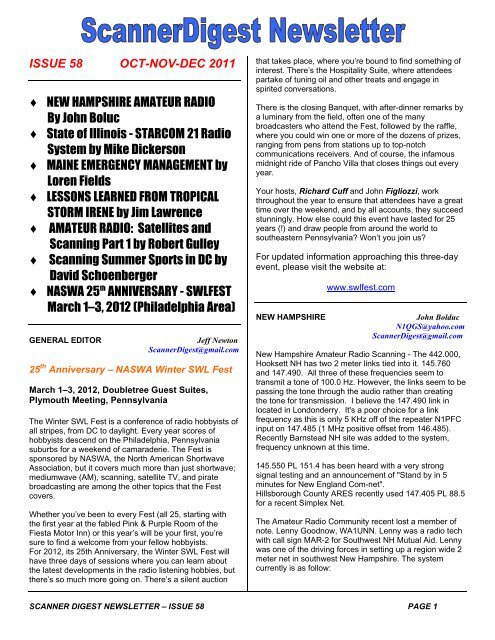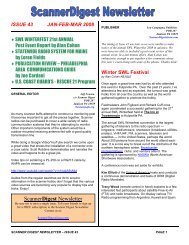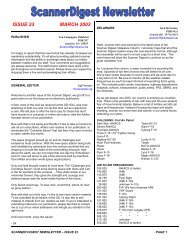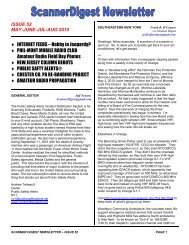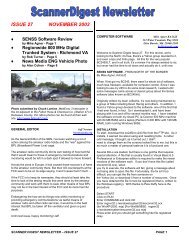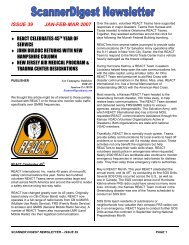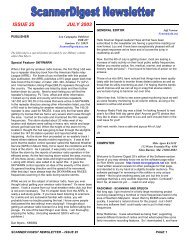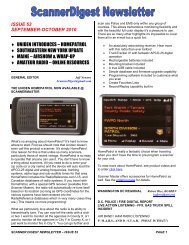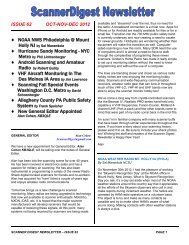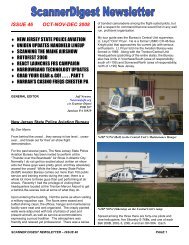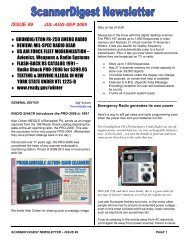Issue 58 - Scanner Digest Newsletter
Issue 58 - Scanner Digest Newsletter
Issue 58 - Scanner Digest Newsletter
You also want an ePaper? Increase the reach of your titles
YUMPU automatically turns print PDFs into web optimized ePapers that Google loves.
EASTERN PENNSYLVANIASteve Bower, Jr.Stevescan60@yahoo.comhttp://lvcomm.proboards33.com/index.cgiIn the latest issue it was written:453.0250 136.5 Carbon Fire North
The change will address “one of the biggest issues facedevery day by firefighters, fire police, EMS and firstresponders,” said Winslow Fire Chief Terrence Osborne.“It is a major concern when the ability to talk to each otherdoesn’t exist or is limited.”The new system also is expected to end a problem withinterference on police radios due to digital TVtransmissions.The expansion would include the ability to integrate allcounty police dispatch services, officials said. Countywideservice already exists for fire and EMS dispatch, they said.Freeholders approved the purchase of the radioequipment from Motorola Solutions Inc. at their meeting inCamden on Thursday. They also approved the separatepurchase of backup radios and other equipment from thesame firm for about $285,000.Reach Jim Walsh at (856) 486-2646 or jwalsh@gannett.comAMATEUR RADIORobert Gulley AK3Qak3q@ak3q.comAmateur Radio: Satellites and Scanning Part 1By Robert Gulley AK3QEmail: ak3q@ak3q.comI have enjoyed a number of hobbies over the years, but Ibelieve the radio hobby has been the most rewardingoverall because it continues to stimulate my curiosity.There are endless opportunities for trying new things, andI am amazed at what has been accomplished in this field.For example, did you know folks regularly bounce signalsoff the moon to talk with other hams around the world?(Yes, I said THE MOON!) Think about this for a moment: asignal originating here on earth travels almost half amillion miles round-trip and is received a few seconds latersomewhere else around the world. I doubt even Marconicould have imagined such a feat!Working Amateur SatellitesIf you are an Amateur Radio operator chances are youhave heard about working satellites or the InternationalSpace Station (ISS), if only as you studied for your radiolicense. You may also have heard about Amateur Radiosatellites built for and by Amateur Radio operatorslaunched into space specifically for use by hams aroundthe world. If you are a scanning enthusiast, you may havenever thought about using your scanner to receive satellitetransmissions, but you can. Most signals are onfrequencies regularly available to most scanners.Even if you know about all the satellites up in the sky,what you may not have realized is just how easy it is tolisten to or even make contact with (if you are a ham)these “birds” as they are affectionately known. You do notneed expensive equipment to listen to or contact some ofthese satellites, and even contacts with the space stationare possible using rather meager equipment.The main difficulty with contactingthe ISS is not the complexity ofthe process involved in makingthe contact, but rather the limitedamount of time astronauts canspend on the air. Hearing the ISSor one of the many satellites asthey fly overhead is fairly easy—itjust requires some patience,technique, and an ever-presentspirit of adventure!One of the more exciting aspects of Amateur Satellitework is the role Hams have played in their development aswell as the truly international cooperation of the AMSATcommunity. Many nations have built and launchedsatellites, and this spirit of cooperation represents the bestof the Amateur community. And even if you are not anamateur radio operator, there is a lot of enjoyment to behad listening in on the multitude of satellite transmissionsthat take place every day, including data, telemetry, andvoice operations.Satellite TransmissionsWhile you might expect that hearing or communicatingwith a satellite would be highly complex, it really is rathersimple, thanks to advances in computers and radioequipment. As you might imagine merely tracking where asatellite is at any given time can be something of achallenge. Fortunately there are a number of programs,many of them free, which will track any number ofsatellites on your computer. There are also Internet siteswhich will do the tracking for you without installinganything on your computer.With some basic information, usually just one’slongitude/latitude position, these software programs canquickly give you a visual representation of a satellite’scurrent position, as well as projected flyover times at yourlocation. Within minutes I can find out which satellites willpass over my house on a given night, grab my radio(s),and start tracking a bird to catch its signals.Knowing where a particular satellite is going to be is morethan half the battle, while finding it with your radio/antennais the rest. While tracking a satellite does not require anexpensive setup, understanding what happens to thesatellite signal as it moves along the sky is very useful.The Doppler ShiftThe Doppler shift, as you may remember from your highschool days, is where the frequency of a wave changes asthe source and destination change in relationship to oneanother. The most common example of this is when youlisten to a siren approaching from an emergency vehicle.The frequency is higher as the sound approaches, andSCANNER DIGEST NEWSLETTER – ISSUE <strong>58</strong> PAGE 11
lower as it moves away. The siren itself is always thesame, but our perception of it changes as it moves inrelationship to us.The same effect happens when listening to radio signalstransmitted by a satellite. As the satellite approaches it isbest received on one frequency, but as it comes directlyoverhead it is on another, and when moving away itmoves to another frequency. When using handheldradios/scanners you will need to make these adjustmentsmanually. Fortunately these adjustments are small, andyou can either tune them in manually or program specificchannels for the shift frequencies and just change to themas needed.Fortunately, a satellite (nor the ground station iftransmitting) needs to use much power to be heard.Satellites can use 1 or 2 watts of power (sometimes evenless) to be received on earth. Five watts from a handheldhere on earth can reach the satellite easily, so power isnot really an issue. Since much of the distance involvesthe vacuum which is space, signals are not obstructed orbounced, thus lowering the power required to transmit.Finally, since satellites operate primarily in the VHF orhigher range, the normal RF issues apply here as they dowith any VHF or higher transmission. The same weatherconditions which affect 6-meter and above contacts mayalso affect satellite contacts, as well as other atmosphericand ground-based interference. While this means treesand other obstructions can prevent line-of-sightcommunications, the higher frequencies are less prone tostatic and other interference common in the lower bands.This makes satellite contact a fairly reliable means ofcommunication, all things considered.Basic EquipmentI doubt back in 1961 when folks started listening toamateur satellites they would have ever dreamed theycould work a bird with nothing more than a handheld radioand a basic telescoping antenna. Many folks, myselfincluded, have labored under the mistaken belief that towork a satellite or the space station one needed complexantennas or a satellite dish like those popularized in spacemovies. Every day of the week folks hear or makecontacts with satellites using very minimal equipment, sodon’t hesitate to use what you already have.I recommend starting out simple and building up yourcapabilities as your interest and/or budget allows. Makeuse of your handheld radio as nothing beats its portability.Depending on the bird you are listening to, a single bandor dual band radio will be required, along with an antennawhich has a bit of gain.ready for this!) . . . a tape measure and some PVC tubing!Do an Internet search for “tape measure antenna” and youwill find lots of homebrew options for a good satelliteantenna.I use a dual bandArrow antenna, acommercialoffering, and onethat has a greatreputation forworkingsatellites. While Iwould nothesitate to buildmy own thesedays, I got thissoon after gettinginto AmateurRadio because Iknew workingsatellites wasone of first thingsI wanted to try.There are alsoother manufacturers who put out a good quality antenna,so don’t hesitate to buy a decent antenna if you are notready to build your own. If you do a YouTube search youcan find several folks who have done greatdemonstrations for using antennas like this, so be sure tocheck them out!Some satellites broadcast their uplink and downlinkfrequencies on the same band, while others receive onUHF and transmit on VHF, and so on. As an example, asatellite may have this listed for its frequencies: Uplink FM145.920, 67Hz PL Downlink FM 435.300 A dual bandradio with built-in diplexer can be useful, but two monobandreceivers work well also. This is the setup I use mostoften, as the antenna I use has dual connectors forVHF/UHF.I like the simplicity of such a setup as it makes it easy tohear the receive portion while I transmit. It is a bit moreawkward to handle two radios, but I built a platform whichmounts to a tripod to hold the radios while I focus onpointing the antenna.While a rubber duck can work, it is extremely limited. Atelescopic whip will do better. Better still, a handheldantenna like the one shown below will work quite well. Asimilarly styled dual band antenna can be made out ofthings you may have around the house like . . . (are youSCANNER DIGEST NEWSLETTER – ISSUE <strong>58</strong> PAGE 12
ResourcesHeavens Above Satellite Flyover Pagehttp://www.heavens-above.com/(great for figuring out when the birds will be near you!)Radio Amateur Satellite Corporationhttp://www.amsat.org/amsat-new/index.php(Premier site for satellite info!)ISS Fan Clubhttp://www.issfanclub.com/(Great info in the ISS including flyover info)As the satellite moves across the face of the earth itscoverage is broad, while the earth-bound station merelypoints toward the moving satellite. Both can use lowpower.<strong>Scanner</strong><strong>Digest</strong> <strong>Newsletter</strong>TechniqueAfter determining where and when a desired satellite isgoing to pass over your location, the hardest part of theprocess is locking on to the signal. I would recommendspending a few evenings practicing this part of the processas you will be surprised at how easy it is to miss thesignal. I was quite lucky my first time out as I locked on tothe signal pretty quickly, only to lose and reacquire it anumber of times.By the way, make sure you keep the squelch open to hearthe transmissions. While many of the satellites are using arepeater, their low power requires the squelch to be openwide so the signals get through—otherwise the relativelyweak signal will not open the radio.Unless you are listening to simplex transmissions on theISS, most of what you will hear will be repeater contactsbetween folks back on earth. These contacts are quickand precise. If you are attempting to make contactyourself, for the sake of all the other folks wanting to makecontacts, follow the lead of those who are already workingthe birds. If the ability comes up some day to have a shortQSO with someone longer than an exchange of ID andgrid location, great! Just make sure you are mindful ofothers trying to make their own first contacts. Save the“ragchewing” for terrestrial contacts!Final ThoughtsNext time around I will talk more about antennas forsatellite work, polarization issues, preamps, and maybeintroduce an antenna or two you might want to buildyourself. Until next time, give the birds a try and havesome fun listening to all the activity going on above you! Iguarantee you’ll be thrilled!DON’T GET LOCKED OUTREQUEST TO BE PLACED ON OURDISTRIBUTION LIST. GET CURRENT ISSUES OFTHE SCANNERDIGEST NEWSLETTER EMAILEDDIRECTLY TO YOU.SCANNER DIGEST NEWSLETTER – ISSUE <strong>58</strong> PAGE 13
MASSACHUSETTESPeter Szerlagzerg90@gmail.comWinchester Hospital Security is confirmed at 461.<strong>58</strong>75 RDPL 7126 Sept 2011 - A Woburn police officer was shot multipletimes responding to a armed robbery of a jewelry store.Woburn PD units remained on their Channel 1 for most ofthe incident. Later on they moved to BAPERN 4(470.5625R). State Police used their trunked systemand their Direct Channel at 868 Mhz. Mutual aid PDsmostly stayed on their home channels. There was a littleP25 on the main Woburn channel at times with NAC 732.Is anyone able to confirm that Athol FD uses 453.175 R -with possible links on 453.5750, 4<strong>58</strong>.5750, 453.9875, and4<strong>58</strong>.9875?Does anybody hear West Boyslton using 39.82 R or453.575 R ?152.96 seems to be a new repeater system. It might beWakefield Water Department. DPL 155. They were heardtesting on 8 Sept 2011.Cambridge PD might have new special use talkgroups- SOPS 1 - TG 17360- SOPS 2 - TG 17392Anybody hear Childrens Hospital in Boston using 151.595R ?Quincy FD has reportedly activated their Channel 2 - it is484.80 R with PL 131.8 - Channel 3 is 451.55 R PL 131.8(which has been in use for a few years by the repair shopand wire guys)During Tropical Storm Irene, a little radio traffic was heardon 142.5625 R PL 167.9- probably MassachusettsNational Guard. Some traffic was also heard on 143.600 RPL 71.9 - it might have been FEMA. Some helo was heardon 49.69 R PL 110.9. Somerville EOC was on 453.55R PL 141.3. Waltham DPW was on 37.94 PL 123.0 briefly.155.925 R PL 77.0 had some Westford DPW traffic.470.35 R PL 146.2 was probably Westford EMA. Bedfordhad public works units on 453.80 R DPL 503 whichis usually Bedford FD Channel 2. I didn’t hear anything on304.8 which might be an air to air freq for HurricaneHunter aircraft.Massachusetts has 4 medical schools - Boston University,Harvard University, and Tufts University are in Boston -University of Massachusetts is at Worcester - all of themhave their own Police Departments since they are notlocated with their primary campusesSomeone has a new repeater on 47.46 - it might be nearGroton - PL 114.8Fitchburg area might have a new school bus repeater on31.08482.05 R - NAC 404 - MSP radio techs being statewidefrom a repeater in the Boston areaHampden FD now using 155.64 R DPL 411 with pagersstill on 33.46 PL 131.8 - per the NetMass State Police have a new statewide talkgroup called"Event 1" (TG 32784) - per the NetBoston PD seems to be setting up a new (or rejuvenated)repeater channel on 460.025 R DPL 506172.95 R - NAC 293 - someone was sending some DTMFtones which sounded really bad - maybe the FAA - 27 Aug2011138.70 - I heard some P25 traffic but it was too weak toget a NAC - the Net says it is Fort Devens MPsPer the Net - Rockland FD did a RIT drill on 25 Aug 2011 -they used Plymouth County Fire Channel 6 Direct -483.925 - PL 173.8Weston FD started to use civilian dispatchers on Aug 12011 (per the Net)Cambridgeside Galleria Mall in Cambridge has theirsecurity units on the Cambridge City TRS now - TG 19568- unconfirmed by meAmherst FD - "fireground" channel is probably 154.8375 -portables only 464.475 R - DPL 223 - Area 4 is the SageBuilding - this must be maintenance or security for somecomplexBoston Fire - in 1944 they changed their radio channelfrom 1630 kc AM to 37.74 Mhz FM - they moved from37.74 to 33.74 on June 27, 1948 - 153.89 went into use asa portable channel on November 26, 1952 - Sept8, 1965 saw the advent of 154.22 as the Metro channel -154.265 went into use in January 1971129.825 AM was heard in use as a MIT flight test channel- as reported on ScanNewEnglandBiddeford Maine Police skip down to me on 159.945 NAC051 quite a bit in the summertime460.925 R is still in use by some traffic reporters in theBoston area121.75 AM was heard in use for a in flight emergencylanding at Logan on 13 Aug 2011150.995 seems to be repeating Byfield FD and NewburyFD comms at times - I think the repeater is in MaineSCANNER DIGEST NEWSLETTER – ISSUE <strong>58</strong> PAGE 14
462.9875 R - PL 123.0 - NorthEast CMED coord net -tested 12 Aug 2011 at approx 1130 AM - approx 30 FDsand ambulance company’s tested372.20 AM - heard Sept 11 2011 - some plane checking inwith some command post or military baseSept 11 2011 - Boston area - North Reading FD beepedthe 2-2 signal at 846 AM on 453.95 - Cambridge FDbeeped the 5-5-5-5 signal at 10 PM on their Channel 1 - incommemoration of the 10th Anniversary of theattack on the World Trade Towers--Welcome to the Massachusetts ColumnPending applications for new radio stations -Revere Schools - 461.5375 - 1 repeater plus 150 mobilesWalpole Public Library - 152.48 - 1 base (6 watts) + 10pagersTown Transportation LLC in Fall River - 160.0275 - 1 base- 160.155 - 20 mobiles at 50 watts eachBerkshire Power at 36 Maylan Lane in Agawam -452.2375 - 10 watt repeater plus 30 portable radiosBrewster DPW - 453.20 RMass Dept of Youth Services at 280 Tinkham Road inSpringfield - 453.05 - 10 watt repeater plus 100 portablesDCU Center at 50 Foster St in Worcester - conventioncenter – portable radios - 456.4625 - 457.4125 - 457.8875- 457.9875Essex County Sheriff at 20 Manning Road in Middleton -470.3375 – 100 watt repeater plus 150 mobilesGreenfield Fire Department - 453.725 - 2 bases and 37mobilesLeonard Grybko - school buses in Deerfield - 159.555 - 1base and 35 mobilesHanover DPW - pending since Aug 2011 - 470.35 - 1repeater and 70 mobilesHoyloke Catholic High School - 15 portable radios at 4watts each - 456.6625 - 456.1875 - 451.1875 - 451.3125 -451.6625Island Fuel on Marthas Vineyard - 159.81 - 10 wattrepeater - 151.67 - 12 mobiles at 20 watts eachMarblehead Schools - 100 portable radios - 462.3125 -467.3125 - analog and digital modesMass State Police - trunking site on Yokum Road in Lenox– pending since May 2011 - 7 channels - 851.875 etcMass Dept of Mental Health Hospital at 20 Vining Road inBoston - 453.05 - 25 watt repeater plus 50 mobilesMcNaim Packaging in Westfield - portables - 456.5375 -457.8125 - 462.5125Needham Public Schools - 60 portables at 2 watts each -451.8750 - 461.7000 - 461.7250 - 462.1750 - 464.6000Orleans Fire Department - 453.8625 R - 453.125 RPlymouth FD - fire boxes - 75.6028 November 2011 - Boston FD was operating at Box5114 in Allston. They had a basement fire in a 7 storybrick building. I noticed that the communications in and outof the basement were pretty bad. Engine 41 was operatinga hose line briefly in the basement. Probably close to75% of his messages were totally unreadable. It was not ahuge deal as a sprinkler head quickly knocked down thefire. But it just goes to show you - it can be very hard totransmit from basements. (483.1875R was the freq)A couple of days prior, BFD had operated in theturnaround area for the Green Line under North Station.Most comms were loud and clear - no doubt becausethere were antennas installed in the undergroundarea. (483.2375R was the freq)BAPERN 3 (470.7875R) had a long problem with a stuckmike one night. Radio techs were making announcementstelling all dispatchers to check for any inadvertentlyactivated patches. I think the problem was fixed afterabout 6 hours.The Boston MedFlight dispatcher lost communicationswith his MF6 ground unit for a short while on 27 November2011. Seems that the NEXTEL radio, the 900 MhzMotortrbo radio, and the UHF radio (460.80R) all wereinsufficient for the task at hand. (MedFlight units alsocarry pagers, but it is unknown if they were 0 for 4 or not)Recently Boston EMS was heard advising all privateambulance service dispatchers to tell their units to turn offtheir CMED radios after giving a patient report to ahospital. Apparently there have been a couple incidents oflengthy stuck mikes on the 463.075 calling channel.27 Nov 2011 - 2 instances of loud "digital intermod" noisewere heard on the Logan FD 453.90 channel yesterday.One time, the noise blocked out a radio message. This"digital intermod" noise, from some unknown source,seems to move from radio system to radio system.Checking my notes, I first heard this noise on 148.15 inNov 2006. Nov 2007 was BFD. Dec 2007 was BFD Ch2.SCANNER DIGEST NEWSLETTER – ISSUE <strong>58</strong> PAGE 15
Dec 2008 was 462.95 BEMS. Oct 2009 was on 483.2875MetroFire. July 2010 was also on 483.2875. Sept 2010 itwas on 470.7875. Oct 2010 was 453.90 and 462.975. Dec2010 was 483.3875. March 2011 was 462.95. Sept 2011was Cambridge FD Ch1. I wonder if this has anything todo with antennas or feed lines that go bad.The Massachusetts Bay Transportation Authority (MBTA)can still be heard on UHF channels. T PD is on 470.6625R- the subways are on other 470 MHz channels. The formerthree bus channels at 472 MHz seem to betotally dead.Recently there have been several stories in the newsmedia about criminals using scanner apps. Posting thisURL -https://sites.google.com/site/scannerstorys/home/2006/tyler-texas---2nd-suspect-charged- in the comments sections of any of those stories mighthelp keep the dogs of encryption at bay.And to all - a good night. (Ho Ho Ho!) (I hope that Santa isgood to you - you have been good, right?)Peter SzPHILADELPHIA METROPosition OpenInteresting in writing?Column Editor WantedWe’re looking for contributors forthe <strong>Scanner</strong> <strong>Digest</strong> <strong>Newsletter</strong>.Contact us for details.<strong>Scanner</strong><strong>Digest</strong>@gmail.com<strong>Scanner</strong><strong>Digest</strong> <strong>Newsletter</strong>Welcome to the <strong>Scanner</strong> <strong>Digest</strong> <strong>Newsletter</strong>! We’re currentlypublishing quarterly e-magazine containing information for thescanner hobbyist. If it can be monitored on a scanner, we’llattempt to cover it from 30 to 1300 MHz and beyond!Our purpose is to produce a newsletter to facilitate theexchange of information pertaining to the various servicescovered by a typical scanner radio. Dedicated regional columneditors make up the heart of this publication.The <strong>Scanner</strong> <strong>Digest</strong> <strong>Newsletter</strong> is not responsible for the accuracyor consequences incurred regarding the use of information listedin this publication. Since the purpose of this newsletter is toprovide a platform for the submission and exchange of radiocommunication information, it thus becomes impossible to deemall contents as accurate. The very nature of radio licensing andusage makes it difficult to verify the accuracy of the informationcontained within. Generally information listed within the pages ofthe newsletter are derived from multiply sources including currentFCC files, hobbyists and those directly involved with variouspublic safety agencies.<strong>Scanner</strong> <strong>Digest</strong>’s policy has been not to limit or edit the individualcolumns submitted, unless we deem the information sensitive innature which may jeopardize the safety of the parties involved.Only in this case will we edit out this type of input.(Example: We will not publish the frequencies used by a lawenforcement surveillance team.)Naturally the comments of the various column editors are notnecessarily the views and opinions of the <strong>Scanner</strong> <strong>Digest</strong><strong>Newsletter</strong>. All materials, maps, information, photographssubmitted to a regional column editor or to <strong>Scanner</strong> <strong>Digest</strong>directly, become sole property of the <strong>Scanner</strong> <strong>Digest</strong> <strong>Newsletter</strong>.We encourage and will make every effort to give proper credit toall submissions. All contents within are copyrighted. 2003-2012Subscription InformationSubscriptions are acknowledged via email. Currently <strong>Scanner</strong><strong>Digest</strong> <strong>Newsletter</strong> produces four (4) issues per year. <strong>Newsletter</strong>swill be emailed to subscribers to via an attachment. The attacheddocument will be in the popular Adobe Acrobat PDF file. Byaccepting these terms you are made aware of the consequences ofopening such attachments. We will scan each outgoing email withan anti-virus tool to minimize any possibility of transmitting aninfectious message.-----------------------------------------------------------------------------Email inquiries to: <strong>Scanner</strong><strong>Digest</strong>@gmail.comVisit our website: www.<strong>Scanner</strong><strong>Digest</strong>.comSCANNER DIGEST NEWSLETTER – ISSUE <strong>58</strong> PAGE 16


